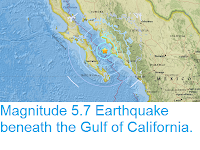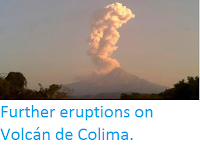The United States Geological Survey
recorded a Magnitude 8.1 Earthquake at a depth of 69.7 km off the coast of southwest
Oaxaca State in southern Mexico slightly before 11.50 pm local time on Thursday 7 September 2017 (slightly before 4.50 am on Friday 8 September
GMT).The event has caused widespread destruction, particularly in Oaxaca State, with the worst damage recorded in the city of Juchitan, were 36 people have been reported dead and about a third of the city's buildings have been destroyed. Nine people have died elsewhere in Oaxaca State, and a further twenty five people in neighbouring states with Chiapas State being particularly badly hit. The event triggered a small tsunami, with waves a meter high recorded on the coast of Mexico, and smaller waves being observed as far away as Fiji.
A damaged building in the town of Matias Romero in Oaxaca State, following the 7 September 2017 Earthquake. AP.
Southern
Mexico is located on the southernmost part of the North American Plate.
To the south, along the Middle American Trench, which lies off the
southern coast off Mexico, the Cocos Plate is being subducted under the
North American Plate, passing under southern Mexico as it sinks into the
Earth. This is not a smooth process, and the plates frequently stick
together then break apart as the pressure builds up, causing Earthquakes
on the process.
The approximate location of the 7 September 2017 Mexico Earthquake. USGS.
The Cocos Plate is thought to have formed about 23 million years ago,
when the Farallon Plate, an ancient tectonic plate underlying the East
Pacific, split in two, forming the Cocos Plate to the north and the
Nazca Plate to the south. Then, roughly 10 million years ago, the
northwesternmost part of the Cocos Plate split of to form the Rivera
Plate, south of Beja California.
The position of the Cocos, Nazca and Rivera Plates. MCEER/University at Buffalo.
In a paper published in the Journal of Geophysical Research, in 2012, a team led by Igor Stubailo of the Department of Earth and Space Sciences at the University of California Los Angeles, published a model of the subduction zone beneath Mexico using data from seismic monitoring stations belonging to the Mesoamerican Seismic Experiment, the Network of Autonomously Recording Seismographs, the USArray, Mapping the Rivera Subduction Zone and the Mexican Servicio Sismologico Nacional.
The seismic monitoring stations were able to monitor not just
Earthquakes in Mexico, but also Earthquakes in other parts of the world,
monitoring the rate at which compression waves from these quakes moved
through the rocks beneath Mexico, and how the structure of the rocks
altered the movement of these waves.
Based upon the results from these monitoring stations, Stubailo et al.
came to the conclusion that the Cocos Plate was split into two beneath
Mexico, and that the two plates are subducting at different angles, one
steep and one shallow. Since the rate at which a plate melts reflects
its depth within the Earth, the steeper angled plate melts much closer
to the subduction zone than the shallower angled plate, splitting the
Trans-Mexican Volcanic Belt into sections above the different segments
of the Cocos Plate, and causing it to apparently curve away from the
subduction zone.
Top
the new model of the Cocos Plate beneath Mexico, split into two
sections (A & B) subducting at differing angles. (C) Represents the
Rivera Plate, subducting at a steeper angle than either section of the
Cocos Plate. The Split between the two has been named the Orozco
Fracture Zone (OFZ) which is shown extended across the Cocos Plate; in
theory this might in future split the Cocos Plate into two segments
(though not on any human timescale). Bottom Left, the position of the
segments on a map of Mexico. Darker area is the Trans-Mexican
Volcanic Belt, orange circles are volcanoes, brown triangles are
seismic monitoring stations, yellow stars are major cities. Bottom
Right, an alternative model showing the subducting plate twisted but not
split. This did not fit the data. Stubailo et al. (2012).
Earthquakes along subductive margins are particularly prone to causing tsunamis, since these often occur when the overlying plate has stuck to the underlying plate, being pulled out of shape by its movement.. Eventually the pressure builds up too far and the overlying plate snaps back, causing an Earthquake and a tsunami.
Witness
accounts of Earthquakes can help geologists to understand these events,
and the structures that cause them. The international non-profit
organisation Earthquake Report is interested in hearing from people who may have felt this event; if you felt this quake then you can report it to Earthquake Report here.
See also...
Follow Sciency Thoughts on Facebook.











